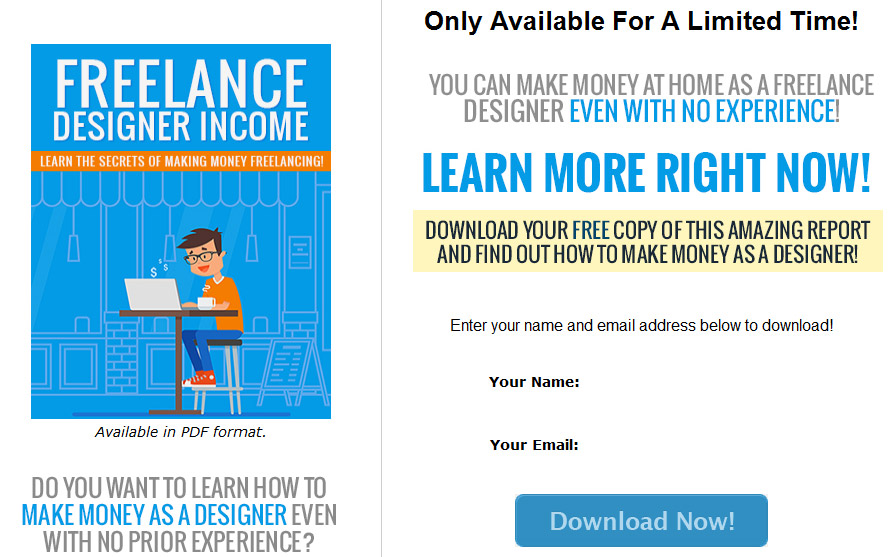Salespage Snapshot:

Table of Contents 3
Introduction 5
Getting Started 6
Computer 6
Internet 8
Software 9
Types of Designers 11
Your Portfolio 13
Getting Work 15
Forums 15
Freelance Sites 16
Gig Sites 17
Classified Sites 17
Contests 18
Conclusion 19
Resources 20
Sample Content Preview
Getting Started
Before you can make money as a freelance designer, there are a few things you must have. If you’re reading this, you probably already have all of these, or at least most of them. If not, we’ll talk about a few ways to get what you need without spending thousands of dollars upfront.
Here’s what you need, at minimum:
1. A Decent Computer – You can’t get away with using a computer with very low specs, unfortunately. Today’s graphics software packages all use considerable resources, so using a 10-year-old laptop with 4 GB of memory just isn’t going to work.
2. Decent Internet – Again, you can’t use really slow internet an expect to do well. Graphic files are often quite large, and a very slow connection is going to frustrate you very quickly. You need at least a 3 Mbps connection to be productive.
3. Design Software – Adobe Photoshop is highly recommended, as there is more support in the form of tutorials, add-ons, etc.
So what if you’re missing part of these things? Let’s talk about some of the ways you can get access to the things you need to get started.
It’s imperative to have a decent computer if you want to design graphics, because most software packages used by designers require a lot of system resources to function properly. You’ll need a decent processor, at least 6-8 GB of memory, and a good graphics card, at minimum.
It’s also helpful to have a larger hard drive, as the files you’ll need to store on it will often be quite large. However, you can get around this requirement by either using an external hard drive to store a lot of your files, or using cloud storage like Dropbox.
Getting a decent computer doesn’t necessarily have to mean spending hundreds of dollars upfront. A lot of people can’t afford to buy a new computer outright.
Financing is probably your best option, but keep in mind that if you don’t have great credit, you’ll end up paying a lot more for your computer, because interest charges on options that don’t require good credit are usually very high.
A lot of places will help you finance a computer without great credit. Here are a few places to consider:
>> http://www.aarons.com
>> http://www.hhgregg.com
>> http://www.rentacenter.com
>> http://www.leaseville.com
Remember to choose a computer that has good specs, because it’s not going to be effective to have a computer that won’t run the software you need to use.
Internet
Not everyone has access to fast internet where they live. There are still a lot of dead zones in the world, and sometimes it’s just not affordable to have internet, even if it is accessible where you live. Fast internet can often cost $100 per month, or more, and if there are no affordable options where you live, you may think you can’t make money as a freelancer.
Fortunately, there are some options available to you even if you don’t live in an area with access to fast, affordable internet.
The first option is using mobile internet. If you have a cellphone, you may be able to use it as a personal hotspot in order to access the internet from your computer. You simply log into the hotspot as you would WiFi, or connect via Bluetooth. Sometimes you can even connect to your phone’s hotspot by plugging your phone into your computer.
If you don’t have a phone that has a hotspot feature, you may be able to get a dedicated hotspot device through your cellphone carrier. Many carriers offer these small devices, and you can often connect several devices to a single hotspot. Of course, you’ll have to be careful about how much bandwidth you use, as mobile bandwidth is often quite expensive, and even “unlimited” plans are never truly unlimited.
The second option is to use the internet at a place like a local college, library, coffee shop, or restaurant. Many places have free WiFi these days, although some do require a small purchase to be able to use it. Even very rural areas usually have some kind of free internet option.
Software
Okay, software is a bit trickier, because aside from theft (which I obviously do NOT condone), there’s no way to really get the type of software you need for free.
You could try to get by using free alternatives, but keep in mind that there won’t be as much support for free software. If you look for tutorials and add-ons, there just isn’t likely to be anywhere near the variety you’d find for software like Adobe Photoshop.
If you insist on using free software, I recommend GIMP:
>> https://www.gimp.org/
As far as free graphics software, GIMP is the most powerful option, and has the most support of any free program.
If you’re looking for power and support, Photoshop is the way to go. Fortunately, you no longer have to shell out hundreds of dollars upfront to buy the software. You can simply get onto a monthly plan through the Adobe Creative Cloud program. Yes, it’s still relatively pricey, but for software this powerful and with the potential to make you as much money as this one, it’s well worth it.
You can get Photoshop (with Lightroom) for $9.99 per month, or you can pay $49.99 per month to get all 20+ Adobe apps, including Photoshop, Illustrator, Dreamweaver, Premier Pro and more.
>> https://creative.adobe.com/plans
There’s also special pricing for students, so if you happen to have a student ID card, you can get a better monthly price. For example, students can get the $49.99 plan for just $29.99.
This is a significant investment, but you can always start with the $9.99 plan for access to Photoshop and upgrade later. The basic plan will be fine when you’re just getting started, unless you plan to also offer video editing or logo creation, in which case you’d need other apps like Premier and Illustrator.
Types of Designers
Before you actually start offering your design services, it’s important to decide what type of design you want to specialize in. It’s never a good idea to just offer “design”. You’ll scare clients off if they don’t see a solid portfolio of experience in the type of design they’re looking for.
Take a look at some different graphic design portfolios. You’ll see that nearly every designer specializes in something.
For example:
• Ecover and minisite design for internet marketing
• Kindle book cover design
• Logo creation
• Banners and other marketing materials
• Print designs (brochures, business cards, flyers, menus, etc.)
• Social media designs
• Infographics
You can always offer additional services along with whatever you specialize in, but it’s important to make your name in a specific genre of design.
Let’s say you specialize in designing logos. You could offer other services such as banner design and print design, but you will make your name specifically as a logo designer.
This is important, because if someone is looking for a logo designer, they want to go to someone who has a lot of experience specifically in logo design. If they come to your site and see a mishmash of different types of graphics, they will probably look elsewhere. They’ll assume you don’t have enough experience designing logos. The same thing goes for someone looking for banners, or print, or anything else. They’ll just assume you don’t have enough experience specifically in what they are looking for, even if you do.
It’s the same reason most people don’t order a hamburger in a Mexican restaurant, or a pizza at a burger joint. They just assume it won’t be as good there as the cuisine that restaurant specializes in.
For this reason, pick one specific area of design you’d like to focus in. Ideally, this will be an area you do have experience in, one you enjoy working in, and one that has some way to easily find clients. For example, print is often difficult to find work in, because clients are often spread out. They don’t hang out in specific places. However, it’s relatively easy to find work designing book covers, because you can just go to various websites, forums, and blogs that authors visit.
Other Details- 1 Ebook (PDF, DOC), 21 Pages
- 7 Part Autoresponder Email Messages (TXT)
- 1 Squeeze Page (HTML, PSD)
- File Size: 3,827 KB














